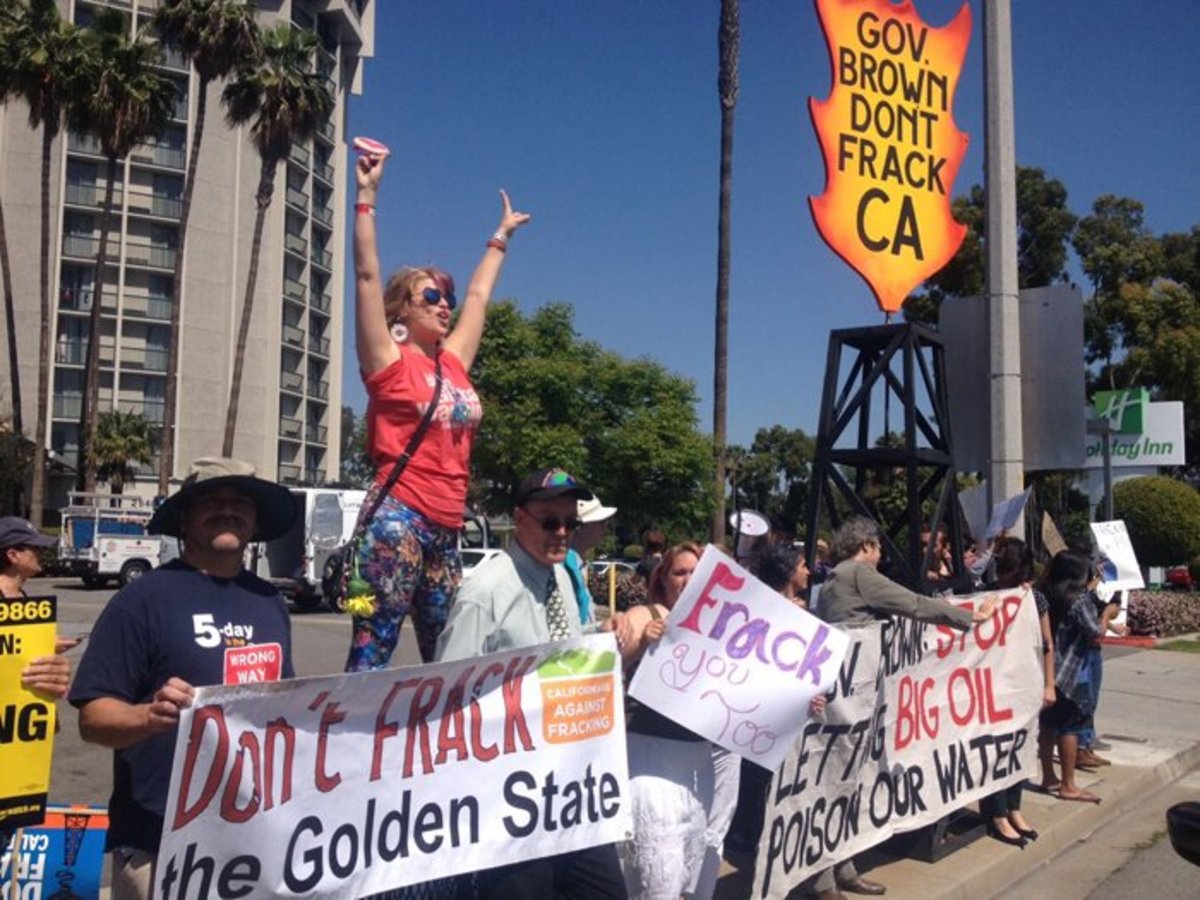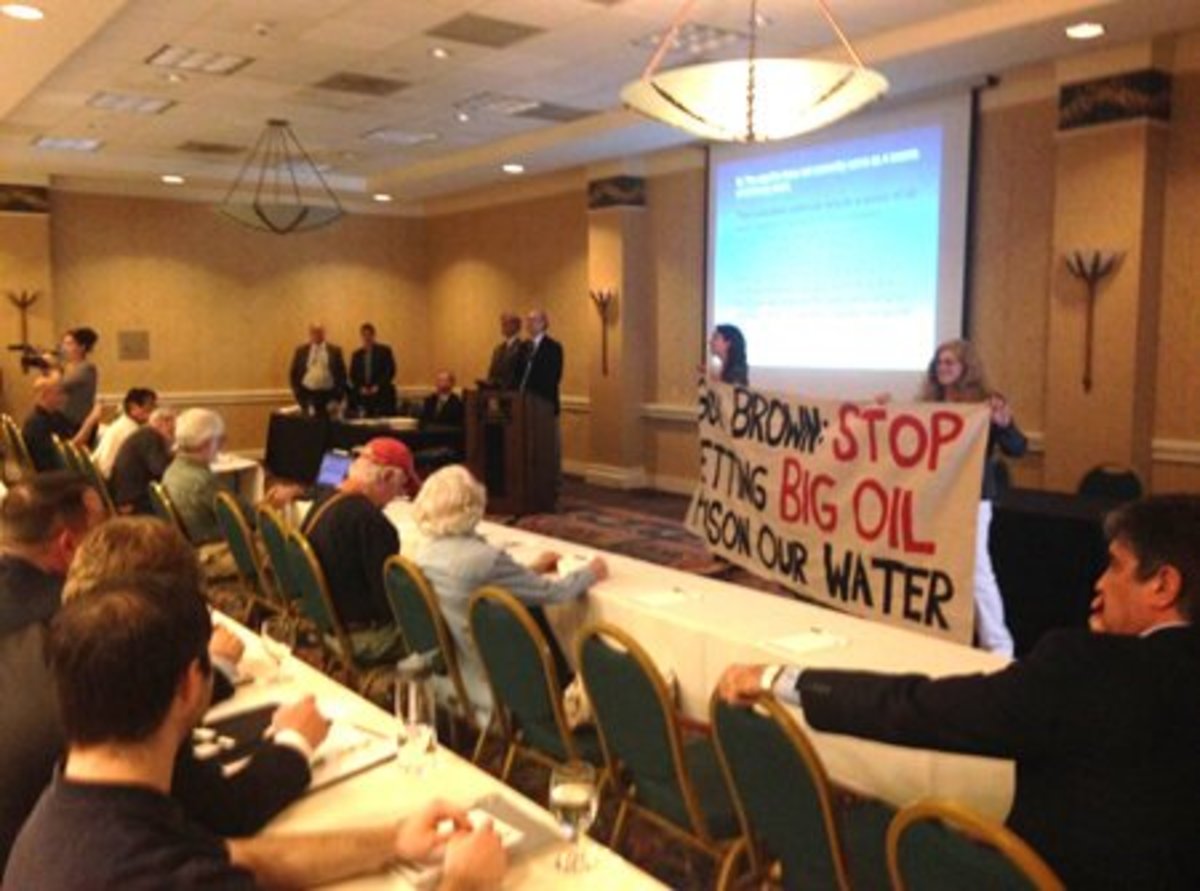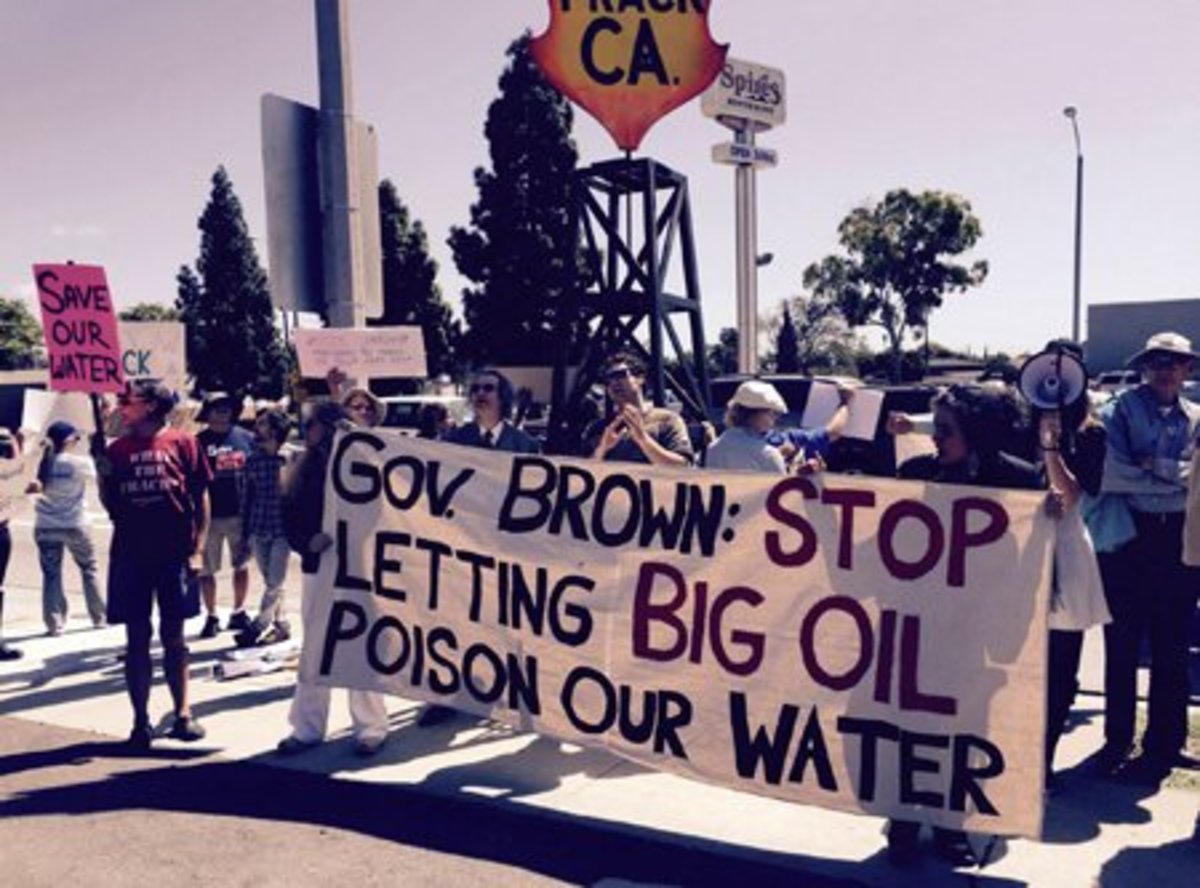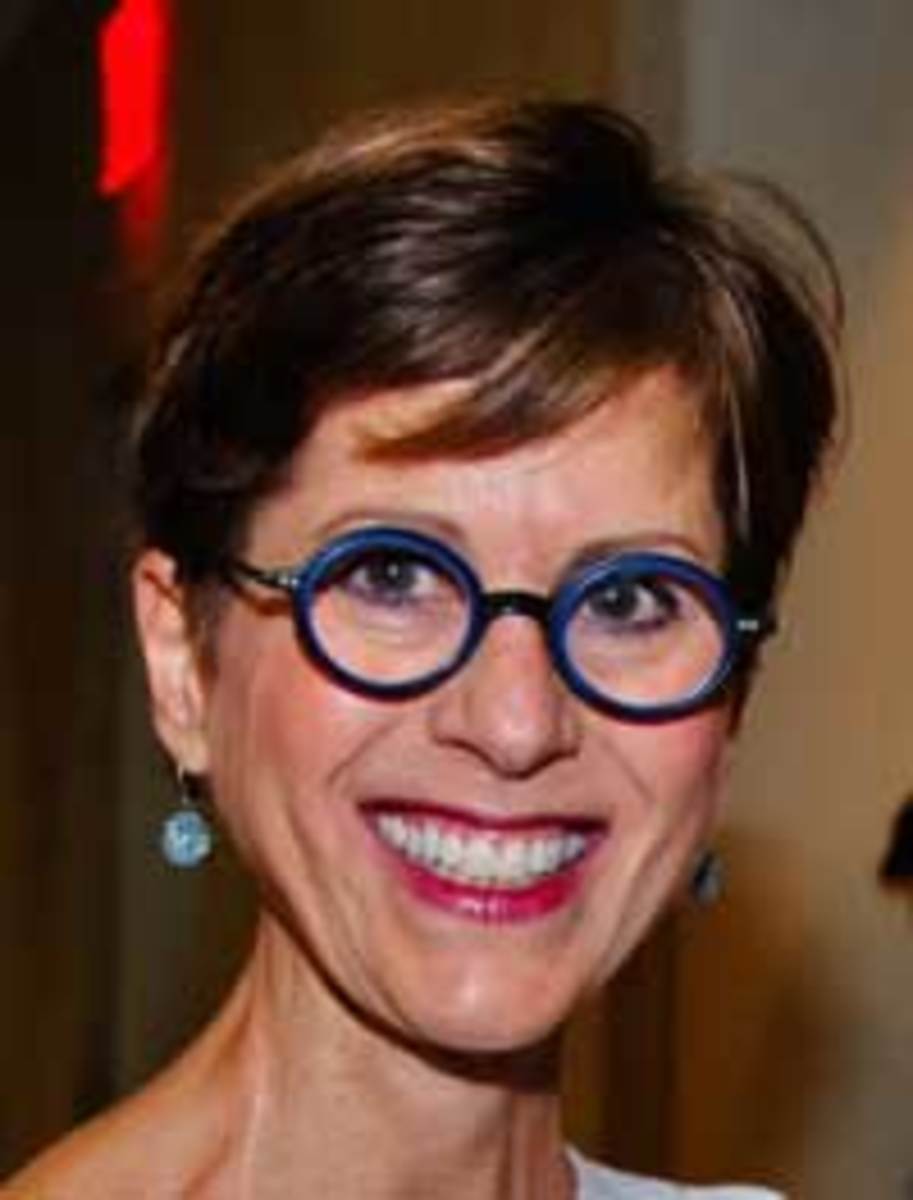Fractivists Bust Up Aquifer Exemption Workshop: Anatomy of an Action
 We were twenty minutes into one of the most boring PowerPoint presentations I have ever seen. While we looked at “shaded areas of cross-sections of multiple productive zones of oil fields,” the regulator was droning on and on. You’d think I’d be nodding off. But no, my heart was beating and my palms were sweating. I was about to do one of the boldest actions I have done since becoming an activist three and a half years ago.
We were twenty minutes into one of the most boring PowerPoint presentations I have ever seen. While we looked at “shaded areas of cross-sections of multiple productive zones of oil fields,” the regulator was droning on and on. You’d think I’d be nodding off. But no, my heart was beating and my palms were sweating. I was about to do one of the boldest actions I have done since becoming an activist three and a half years ago.
Professionally dressed in a sedate gray dress and heels, I was seconds away from disrupting something called an “aquifer exemption workshop” led by DOOGR — the Division of Oil, Gas and Geothermal Regulation –the very state agency that recently had been exposed for illegally allowing oil companies to inject toxic fracking wastewater into 2500 wells near California aquifers.
Since learning about the horrific practice of hydro-fracturing, commonly known as fracking three years ago, I have signed petitions, lobbied legislators, attended and organized rallies and spoken at conferences and on the radio. I even led a statewide petition campaign in 2013 that garnered 20,000 signatures. It asked a state senator to withdraw her weak fracking regulatory bill and fight for a ban instead. I wrote about it earlier here. The senator did not listen; and a year after the legislation was passed, as predicted, it was being ignored.
We found out about this “aquifer exemption workshop” where the regulators would outline “the data requirements and process for requesting an aquifer exemption under the Safe Drinking Water Act,” so Big Oil could continue to pollute our drinking water. Californians Against Fracking, a coalition of over 200 organizations in the state, was planning to do a demonstration outside the workshop. But some of us wanted to go one step further and actually disrupt the meeting.
I have been inspired by the work of Kevin Zeese and Margaret Flowers, from PopularResistance.org, who have been disrupting governmental hearings in the nation’s capital ever since 2009 when Margaret was arrested in the Senate Finance Committee hearing on healthcare after she stood up to condemn the chairman for not having any single-payer advocates in the room. Their recent work to preserve Net neutrality and fight the Trans-Pacific Partnership has been particularly creative. I have also long admired the work of Medea Benjamin and the fearless activists of Code Pink. Last month they got inches away from putting handcuffs on war criminal Dick Cheney at a Senate Foreign Relations Committee hearing. While I had pointed my finger into the nose of an LAPD officer who stopped me from leading a Net neutrality march two blocks from the site of an Obama fundraiser last year, I had never done anything that bold. So it didn’t take me too long to tell the group that I was on board.
 In trying to recruit other disruptors, I felt very mysterious emailing and Facebook messaging five other activists asking them to call me about something important. I didn’t want to put anything in writing on the Internet. Having organized four protests at Obama fundraisers and having stupidly shown my license to Hillary Clinton’s Secret Service agent while leading a Not Ready for Hillary protest last year, I assume “they” are watching me. It may be wishful thinking, but I imagine they are less likely to be listening in on my actual phone conversations than they are monitoring my email and Facebook page.
In trying to recruit other disruptors, I felt very mysterious emailing and Facebook messaging five other activists asking them to call me about something important. I didn’t want to put anything in writing on the Internet. Having organized four protests at Obama fundraisers and having stupidly shown my license to Hillary Clinton’s Secret Service agent while leading a Not Ready for Hillary protest last year, I assume “they” are watching me. It may be wishful thinking, but I imagine they are less likely to be listening in on my actual phone conversations than they are monitoring my email and Facebook page.
We had an organizing call the night before the workshop where we determined the plan of action. After discussing several scenarios, we decided that we would scatter around the room. That way if security tried to drag us out, it would take them longer to get every one of us; and by then, we would have finished delivering the message we had scripted out. We were told that a room had been rented in the Long Beach Holiday Inn where the workshop was. So we all agreed to meet there the next morning to rehearse.
Arriving at the hotel two hours before the workshop was to begin, I was pleasantly surprised to see how well we activists had “cleaned up” dressed in our best professional business attire. It was decided that Susan, a local Long Beach resident, would be the first to interrupt by asking the innocent question: “What is this workshop all about?” And then the disarming zinger: “Is it to teach them how to continue to poison our water?”
A few minutes later I would chime in. Right after that, Alicia would pull out two bottles of “frack water,” bring them to the regulators and ask them if they would drink it. Then Antonietta would shout out. “This must stop.” We would all stand up and echo her. As Alex Nagy from Food and Water Watch and Elizabeth Lerer, a grassroots activist, unfurled our banner which said “Gov Brown, Stop Letting Big Oil Poison Our Water,” Hamid would deliver a pink slip to the regulators and tell them they were all fired. We would close by reciting in unison a manifesto of how “we the people” would not allow them to continue to poison our water and then start chanting until they hauled us out of there.
Clark Davis from thesyndicate.info media collective would videotape. Lou Noble, from Peoples Media By the Peoples, would livestream. Lorraine from Occupy Venice would shoot stills. And Walker Foley from Food and Water Watch would liaise with the cops. We agreed that as soon as he raised his fist, it would be time to leave. It was decided by consensus that this was not to be an arrestable action. We rehearsed it several times with Revolutionary Poet Antonietta advising us where to pause, and Walker played the regulator. He had us in stiches talking randomly about his golf game instead of regulations. After a few run-throughs, we high- fived ourselves. It was tight.
But there were some uncertainties. What if we had to sign in? Would we use our real names or would we make up identities. Walker became Trevor Jones from Entek, a small Colorado energy company looking into the Los Angeles market. I decided to be a law student from a nearby law school. I don’t know what other people decided, because it was time to go downstairs. We each went down separately and agreed not to talk to each other when we went in.
To our surprise, the regulators didn’t try to shut us down. Security didn’t storm the room. None of the workshop attendees booed us. So we continued the same chant for three minutes.
To our surprise, the regulators didn’t try to shut us down. Security didn’t storm the room. None of the workshop attendees booed us. So we continued the same chant for three minutes.
Our worries were in vain. There was no sign in table and no security. The few CHP officers on the premises were outside monitoring the protest on the street. We walked right in and assumed our places being very intent not to look at each other. A man on my right looked at me and said, “I know you. You’re Lauren.” I couldn’t place him. But I mumbled under my breath, “You don’t know me.” “Yes, I do,” he said. “No, you don’t,” I said. And that was that. I don’t know what I was anticipating. I was just focused on not blowing my cover. This cloak and dagger stuff was exciting.
Everything went as planned. Susan asked her question. The regulator responded that there would be time for questions afterward. Then a couple minutes later, I stood up. “”I’m sorry. I just have to say one thing. This is backwards. It was just announced in the news that industry injected 2,500 wells illegally, and DOGGR admitted they didn’t know this was going on. Shouldn’t you be having a workshop on how to stop that instead of how to get around, to get exempt from these regulations?”
 The presenter responded, “Actually, we have a compliance agreement with EPA that we will discuss as part of the presentation. I really would prefer that people not interrupt the presentation. This is not about having a protest when we’re trying to get something accomplished.”
The presenter responded, “Actually, we have a compliance agreement with EPA that we will discuss as part of the presentation. I really would prefer that people not interrupt the presentation. This is not about having a protest when we’re trying to get something accomplished.”
Now it was Alicia’s turn. “I actually brought some poisoned water to show everyone what we’re going to be exposed to and forced to drink if this poisoning of our water by our regulators continues.” She approached the podium and placed the bottles in front of the regulators. “Would you feel like drinking this water?”
“Excuse me, ma’am, we will have…” the official started to say. “Excuse me. Try this water and tell us if you feel like drinking the water that you are polluting for our children, and for us, and that you have been allowing for so long! You are the regulators.” Antoinetta pipes in: “This needs to stop.” Everybody stands up: “This needs to stop,” we shout in unison.
Cue Hamid: “You are our regulators. You are have violated your mission. We hereby serve you your pink slip. Thank you” He placed the paper down and led us in this recitation: “We, the people of California, fire you from your post. Shame on you, for colluding with Big Oil, to poison our aquifers. In this year of record drought, in this era of a warming climate, it is reprehensible that you are teaching them how to exploit our laws to poison our water!”
“Our aquifers are not toxic waste dumps!” shouted Mark Lipman from the back of the room. Then we chanted over and over:
“One, we are the people!
Two, you can’t ignore us!
Three, we will not let you
poi- son our wa-ter!”
Two, you can’t ignore us!
Three, we will not let you
poi- son our wa-ter!”
 Had we anticipated we would be allowed to go on for so long, we probably would have come up with more chants. One woman approached Alex and told her we had to leave. But Alex just smiled and kept chanting. The woman then tried to reason with Hamid.
Had we anticipated we would be allowed to go on for so long, we probably would have come up with more chants. One woman approached Alex and told her we had to leave. But Alex just smiled and kept chanting. The woman then tried to reason with Hamid.
After the hotel officials left the conference room, presumably to call the cops, Mark started another chant “Shame on you!” punctuated with Alicia calling out, “The regulators!”
As two uniformed police officers entered, I decided to start a new chant, “Ban fracking now!” Then Walker raised his fist. We all raised our fists and started filing out, all the while chanting our final message:
“Water can’t be poisoned for private wealth.
We will fight for our children’s health!”
We will fight for our children’s health!”
Once outside the room, we chanted,
“Shame on you! We’ll be back!”
After the room quieted inside, one conference attendee remarked, “They take our water seriously!” The man delivering the presentation responded, “So do we, we take your water seriously too.”
Obviously this is not the case; as DOGGR admitted to wrongly issuing about 500 permits for waste disposal wells that violate both federal and state law. However, the state has shut down just 23 of the hundreds of illegal wells that have dumped billions of gallons of hazardous oil waste into protected aquifers. More than 2,000 enhanced oil recovery wells are also operating illegally in protected aquifers.
Up to half of California wells are fracked. Oil companies’ own tests show high levels of cancer-causing benzene in flowback fluid from fracked wells in California. Those tests, mandated by a new fracking disclosure law, found benzene at levels as high as 1,500 times the federal limits for drinking water. Those documents also show that fracking flowback is typically disposed of in wastewater injection wells.
Produced water, which comes from fracked wells and conventional wells alike, also can contain high levels of benzene and other chemicals. State oil officials’ own study detected levels thousands of times the federal limits. In California, roughly 113 billion gallons of produced water is dumped into wastewater disposal wells each month.
After the illegal aquifer dumping was revealed earlier this year, more than 150 environmental and community groups filed a legal petition urging Gov. Brown to use his emergency powers to place a moratorium on fracking and other well stimulation techniques. And just last week, eight California legislators sent a letter to Governor Brown asking him to immediately shut down all injection wells.
After we left the hotel, we joined up with the activists on the street who were chanting “Governor Brown, It’s not too late. Protect the water of our state.” We had a de-brief of our action, talking about what worked and what we could have done better. But by and large, we were all pretty pleased with what we had accomplished. The only downside was there was no mainstream media there to share our wonderful action with the people of California. So we rushed off to edit videos, write articles and do our magic on social media
 Last weekend, on “Meet the Press,” Jerry Brown said despite the drought, despite the fact that a NASA scientist said there is only one year’s worth of water left in our reservoirs, and despite the fact that fracking and other extreme extraction processes use two millions of gallons of fresh water a day, he saw no reason to ban fracking. It may be time to ramp up our tactics. Who knows? My next article might be about us chaining ourselves to an oil derrick.
Last weekend, on “Meet the Press,” Jerry Brown said despite the drought, despite the fact that a NASA scientist said there is only one year’s worth of water left in our reservoirs, and despite the fact that fracking and other extreme extraction processes use two millions of gallons of fresh water a day, he saw no reason to ban fracking. It may be time to ramp up our tactics. Who knows? My next article might be about us chaining ourselves to an oil derrick.
Lauren Steiner
The TRUTH will set you FREE.











 ;
;